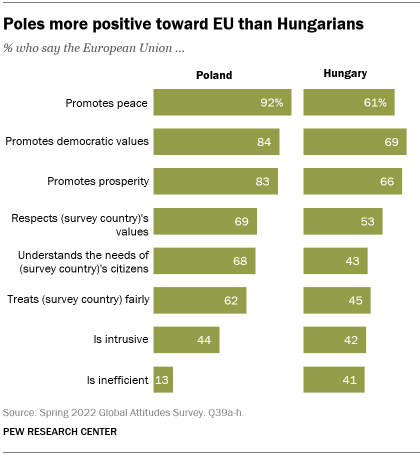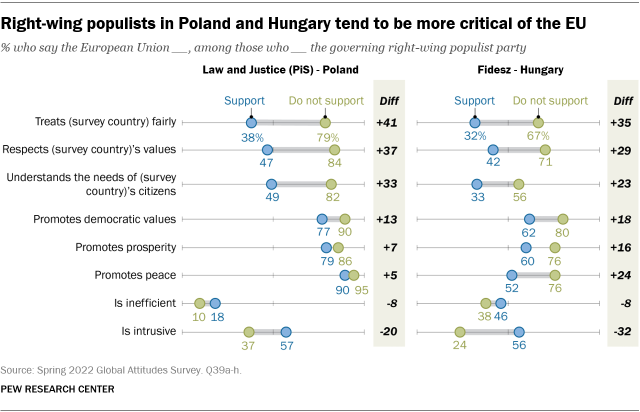
The governments of Poland and Hungary – both controlled by right-wing populist parties – have clashed with the European Union over myriad issues in recent months, including the independence of their media and judiciaries as well as sanctions against Russia. Despite these and other disputes, the Polish and Hungarian people express largely positive views of the EU, according to a recent Pew Research Center survey.

At least eight-in-ten adults in Poland and six-in-ten in Hungary say the EU promotes peace, democratic values and prosperity. Most in Poland also feel the EU respects their country’s values, understands the needs of Polish citizens and treats Poland fairly, though considerably fewer in Hungary say the EU does the same for their country.
In both countries, sizable shares of the public see the EU in a negative light on one measure: 44% of Poles and 42% of Hungarians see the EU as intrusive. A similar share of Hungarians (41%) say the EU is inefficient, though just 13% of Poles agree.
This Pew Research Center analysis focuses on Hungarian and Polish views of the European Union, as well as their views about the societal acceptance of homosexuality – a key political dispute recently between populist governments in both countries and the EU.
The analysis draws on nationally representative, face-to-face surveys of 1,041 Hungarian adults conducted from April 19 to June 3, 2022, and 1,043 Polish adults conducted from March 21 to May 5, 2022. Here are the questions used for this analysis, along with responses. Visit our methodology page for more information about the survey methods used outside the United States.
Evaluations of the EU vary widely between supporters and nonsupporters of the right-wing populist parties in power in each country.
In Poland, supporters of the ruling Law and Justice Party (PiS) are far less likely than nonsupporters to say the EU respects Poland’s values (47% vs. 84%), understands the needs of Poland’s citizens (49% vs. 82%) and treats Poland fairly (38% vs. 79%).
In Hungary, the pattern is similar. Supporters of the ruling Fidesz party are less likely than nonsupporters to say the EU respects their country’s values (42% vs. 71%), understands the needs of Hungarian citizens (33% vs. 56%) and treats Hungary fairly (32% vs. 67%).

One major fault line between the EU and the right-wing populist governments in Poland and Hungary in recent years has been LGBTQ+ rights. Poland, which ranks lowest in LGBTQ+ rights among 27 EU member states according to Rainbow Europe, has had funding withheld over the self-imposed “LGBT free” status of roughly 100 municipalities and regions in the country (Polish courts have since ruled that these “zones” must be abolished in four municipalities, and three regional councils have repealed the declarations in order to maintain their funding). Separately, the EU is suing Hungary over a restrictive law that bans depictions of homosexuality or sex reassignment in media targeting young people.
Despite these political clashes, more Poles and Hungarians say homosexuality should be accepted by society than say it should not be.

In fact, the 53% of Poles and 52% of Hungarians who say homosexuality should be accepted by society are the highest shares recorded in each country since Pew Research Center began asking (in 2002 in Poland and 2019 in Hungary). This year also marks the first time that significantly more Poles have expressed the view that homosexuality should be accepted than should not.
Like views of the EU, support for the acceptance of homosexuality is and has been a partisan issue in Poland and Hungary. In both countries, roughly two-thirds of those who oppose the governing right-wing populist party say homosexuality should be accepted (68% in Poland and 67% in Hungary). Just 32% of PiS supporters in Poland and 42% of Fidesz supporters in Hungary agree.
Views on homosexuality are associated with views of the EU in both countries, as those who support the acceptance of homosexuality are much more likely to offer favorable opinions of the EU on nearly all characteristics.
Note: Here are the questions used for this analysis, along with responses and the full dataset. Visit our methodology page for more information about the survey methods used outside the United States.



